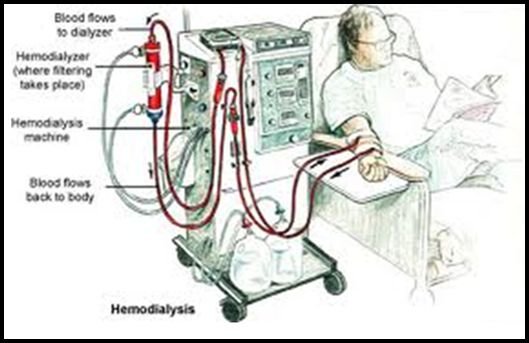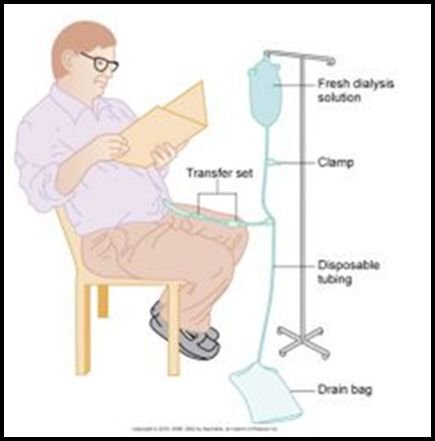Dialysis
Dialysis in Chennai
Dialysis is a treatment that does some things done by healthy kidneys. It is needed when your kidneys can no longer care for your body’s needs.
When is Dialysis needed?
It would be best if you had Dialysis when you develop end-stage kidney failure –usually, by the time you lose about 85 to 90 percent of your kidney function and have a GFR of <15.
What does Dialysis do?
When your kidneys fail, dialysis keeps your body in balance by:
- removing waste, salt and extra water to prevent them from building up in the body
- keeping a safe level of certain chemicals in your blood, such as potassium, sodium and bicarbonate
- helping to control blood pressure
Is kidney failure permanent?
- Usually, but not always. Some kinds of acute kidney failure get better after treatment. In some cases of acute kidney failure, dialysis may only be needed for a short time until the kidneys get better.
- In chronic or end-stage kidney failure, your kidneys do not get better, and you will need Dialysis for the rest of your life. If your doctor says you are a candidate, you may choose to be placed on a waiting list for a new kidney.
Where is Dialysis done?
Dialysis can be done in a hospital, in a dialysis unit that is not part of a hospital, or at home. You and your doctor will decide which place is best, based on your medical condition and wishes.
Are there different types of Dialysis?
Yes, there are two types of Dialysis –hemodialysis and peritoneal Dialysis.
What is hemodialysis?

- In hemodialysis, an artificial kidney (hemodialyzer) removes waste and extra chemicals and fluid from your blood. To get your blood into the artificial kidney, the doctor needs to make an access (entrance) into your blood vessels. This is done by minor surgery to your arm or leg.
- Sometimes, access is made by joining an artery to a vein under your skin to make a bigger blood vessel called a fistula.
- However, if your blood vessels are not adequate for a fistula, the doctor may use a soft plastic tube to join an artery and a vein under your skin. This is called a graft.
- Occasionally, access is made using a narrow plastic tube called a catheter inserted into a large vein in your neck. This type of access may be temporary but is sometimes used for long-term treatment.
How long do hemodialysis treatments last?
The time needed for your dialysis depends on:
- how well do your kidneys work
- How much fluid weight do you gain between treatments?
- how much waste you have in your body
- how big you are
- the type of artificial kidney used
Usually, each hemodialysis treatment lasts about four hours and is done three times per week.
A type of hemodialysis called high-flux dialysis may take less time. You can speak to your doctor to see if this is an appropriate treatment.
What is Peritoneal Dialysis, and how does it work?

In this type of dialysis, your blood is cleaned inside your body. The doctor will do surgery to place a plastic tube called a catheter into your abdomen (belly) to make access. During the treatment, your abdominal area (called the peritoneal cavity) is slowly filled with dialysate through the catheter. The blood stays in the arteries and veins that line your peritoneal cavity. Extra fluid and waste products are drawn out of your blood and into the dialysate.
What are the different kinds of peritoneal dialysis, and how do they work?
There are several kinds of peritoneal dialysis, but two major ones are:
- Continuous Ambulatory Peritoneal Dialysis (CAPD)
- Automated Peritoneal Dialysis (APD)
Continuous Ambulatory Peritoneal Dialysis (CAPD)
CAPD is the only type of peritoneal dialysis that is done without machines. You do this yourself, usually four or five times a day at home and/or at work. You put a dialysate bag (about two quarts) into your peritoneal cavity through the catheter. The dialysate stays there for about four or five hours before being drained back into the bag and thrown away. This is called an exchange. You use a new bag of dialysate each time you do an exchange. While the dialysate is in your peritoneal cavity, you can go about your usual activities at work, school, or home.
Automated Peritoneal Dialysis (APD)
APD is usually is done at home using a particular machine called a cycler. This is similar to CAPD, except several cycles (exchanges) occur. Each cycle usually lasts 1-1/2 hours, and exchanges are done throughout the night while you sleep.
Frequently Asked Questions –
- Will dialysis help cure kidney disease?
No. Dialysis does some of the work for healthy kidneys, but it does not cure your kidney disease. You will need to have dialysis treatments for your whole life unless you can get a kidney transplant.
- Is Dialysis uncomfortable?
When the needles are put into your fistula or graft, you may have some discomfort, but most patients have no other problems. The dialysis treatment itself is painless. However, some patients may have a drop in their blood pressure. If this happens, you may feel sick to your stomach, vomit, have a headache or have cramps. With frequent treatments, those problems usually go away.
- How long can you live on Dialysis?
We do not yet know how long patients on dialysis will live. We think that some dialysis patients may live as long as people without kidney failure.
- Do dialysis patients feel normal?
Many patients live everyday lives except for the time needed for treatments. Dialysis usually makes you feel better because it helps many of the problems caused by kidney failure. You and your family will need time to get used to Dialysis.
- Do dialysis patients have to control their diets?
Yes. You may be on a special diet. You may not be able to eat everything you like, and you may need to limit how much you drink. Your diet may vary according to the type of Dialysis.
- Can dialysis Patients travel?
Yes. Dialysis centers are located in almost all the major centers in India and Abroad. The treatment is standardized, and you must make an appointment for dialysis treatments at another center before you go.
- Can dialysis patients continue to work?
Many dialysis patients can go back to work after getting used to Dialysis. If your job has a lot of physical labor (heavy lifting, digging, etc. ), you may need to get a different position.
